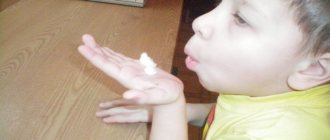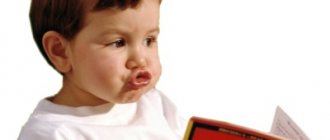Secrets of successful sound automation
Hooray! And so the sound was born!
The child has learned to pronounce a sound in isolation, which means it is possible and necessary to move on to the next stage - sound automation , that is, teaching the child the correct pronunciation of a given sound in coherent speech.
You should not dwell on the individual pronunciation of sounds for long, since our speech is a stream of continuous changes, and the movements of the lips and tongue when pronouncing consonants are not standard, but depend on the composition of which set of movements (that is, in which sound combinations) they are carried out . This determines the importance of switching on the newly developed sound as quickly as possible in its most typical sound combinations.
The pronunciation of sounds must be fixed in the child’s speech. Otherwise, in everyday speech he will still pronounce his old sound. And it is even more correct to differentiate with an earlier pronounced, even distorted sound (for example, learn to distinguish the correct “R” sound from the throaty pronunciation of the sound). Children get used to the “old” sound not only articulatory, but also auditory.
You can automate and differentiate sounds at the same time!
However, there is no need to go to the other extreme - move to the automation stage prematurely, that is, before obtaining the correct isolated sound sound.
The stage of automation of sounds can be considered complete only when the child masters the skill of correctly pronouncing a “new” sound in ordinary conversational speech, in everyday life.
Often in practice there are cases when, having mastered the correct pronunciation of sounds, they do not use them in their independent speech or have “office speech” (only in the speech therapist’s office they speak correctly).
Help from parents and educators at this stage is simply irreplaceable. Full control of all the child’s speech in ordinary life situations is necessary.
An incorrectly pronounced sound must be corrected every time. This is exactly what will ensure complete automation of sounds, and in the shortest possible time, in order to save parents from the need to take them to a speech therapist. After all, as you grow older, the habit of speaking becomes fixed and may have the nature of a second habit.
It is better to start producing and then automating sounds no later than 5 years, so that the child does not develop “experience of incorrect speech.”
But it is also necessary to take into account sound culture at every age of the child. Sounds “come” to the child in stages. In each age period we expect certain sounds.
The appearance of sounds in speech:
- 3-4 years - whistling sounds “s”, “s”, “z”, “z”, “ts”
- 4-5 years - hissing sounds “sh”, “zh” “ch” “sch”.
- 5-6 years - sonorant sounds “l”, “l”, “r”, “ry”.
You can evaluate how speech develops in each age period. If a child is lagging behind in the development of sound pronunciation, you can take appropriate measures - start studying in a form that is easy for the child, through play!
Stages of sound automation
Most speech therapists know from practice how long and tedious the process of automating sounds in children can be. How much work and patience is needed, how varied the speech material must be in order to captivate children and increase interest in speech therapy classes.
Sound fixation occurs in stages:
- Consolidation in syllables.
- Consolidation in words.
- Consolidation in phrases, sentences.
- Consolidation in the child’s everyday speech.
Techniques for Successful Sound Automation
Fixing a sound gives a higher level of automation associated with distraction from pronunciation by the following stimuli:
— “ Visual ” (to unload the child’s audio channel we use pictures, diagrams, objects, mnemonic tables, toys, algorithms, tables...)
- “ Tactile-muscular ” (we use sensation through the fingers of our hands through writing, modeling letters, finger games in combination with poetry, poetry in combination with movements of general motor skills and coordination of movements.
— “ Bioenergoplasty ” (pronouncing verbal material using movements of both hands simultaneously)
- “ Theatrical ” (intonation of syllables, words, phrases - pronounced with surprise, questioningly, shyly, with sadness, with an exclamation...)
- “ Closed eyes technique ” (we pronounce verbal material with our eyes closed, concentrating our attention on articulation, on phonemic hearing. You can pronounce the material to the child at the moment when he closes his eyes).
— “ Maximum involvement of analyzers in sound automation .” It's no secret that the more analyzers are involved in the learning and correction process, the more successful the result will be. The child sees, hears, feels, touches...
The most important secret of sound automation is positive emotions and genuine interest in activities for adults and children!
And when there is interest, there is a great desire to achieve a result that will not keep you waiting!
| Starostina Marina Aleksandrovna, speech therapist teacher, MBDOU No. 30, Chusovoy |
- Presentation [Syllable tables for sound automation]
- Methodological development for sound automation
- Cards with tasks for automating sounds
- Individual lesson on sound automation [L] in syllables, words, phrases, connected text [Differentiation of sounds L – R]
- Mnemonic tables for individual work at the stage of sound automation
( 7 liked, average score: 4.86 out of 5)
Loading...
Consultation “Automation of sounds at home”
Elena Kasyanova
Consultation “Automation of sounds at home”
«Automating sounds at home»
Goal: to introduce parents to the principles and techniques of automating delivered sounds at home .
By regularly attending speech therapist classes, the sound pronunciation of a preschooler can acquire the character of “desk speech”
when in the speech therapist’s office
(or when asked to repeat correctly) the sounds are clear , but in free speech the child pronounces the same sounds distorted. This indicates that the process of sound pronunciation correction is at the “
automation ” .
The speed of passing this stage depends on the frequency of completing homework aimed at automating the assigned sounds . Ideally, daily automation for at least 5-15 minutes a day.
Automate sound - introduce it into syllables, words, sentences, coherent speech. The delivered sound is still very fragile ; the conditioned reflex connection without reinforcement can quickly collapse.
to automating a given sound only when the child pronounces it in isolation completely correctly and clearly with prolonged or repeated repetition, that is, when the teacher-speech therapist “set” sound for the child.
.
Automation of sound is carried out according to the principle from easy to difficult, and is carried out in a strict sequence:
• automation of sound in syllables (direct, reverse, with a combination of consonants)
;
• automation of sound in words (at the beginning of the word, middle, end)
;
• automation of sound in sentences;
• automation of sound in pure tongue twisters , tongue twisters and poetry;
• automation of sound in short and then long stories;
• automation of sound in spoken language.
You can move on to new material only if you have mastered the previous one.
Games for automating set sounds at home .
Learn to play with your child, using any suitable moment for this.
Working on sound , from its production to its use in independent speech, is the development of a new complex skill. And like any skill, it requires effort, time and a certain system in classes, including when doing homework .
I offer you interesting games on sound automation .
"Let's start the car"
You will need a piece of paper and markers. We draw a road with stops and gas stations. At the beginning of the road, we draw a car and ask it to be driven, etc., etc. And when it starts, we drive from one point to another, we say drrrrrrrrrrr.
"Singing Lines"
The child is given colored pencils. Take a red pencil, draw a line and pronounce the given sound . Different colors - different sounds
"Shop"
Prepare different items or foods. Invite your child to choose to buy products that have a given sound .
"Building a tower"
The child builds a tower and names words with the given sound . You can all play together and arrange a competition “Whose tower will be taller”
"Puzzles"
For this game you will need: 6-7 pictures or toys, the name of which contains an attached sound . Together with your child, name them, highlighting the desired sound . Then describe any of them, the child must guess what it is about and name the desired picture or toy. Repeat the game several times. Now offer your child the role of leader. Your possible mistakes will certainly increase your child’s interest in the game.
“What’s missing?”
You can use the same pictures or toys. Invite your child to carefully look at the pictures again, name them, remember them and close their eyes. At this time, remove one or two pictures. The child, opening his eyes, must say what is missing. Repeat the game several times, changing roles with your child.
"What changed?"
This is one of the variants of the previous game. You can change the places of the pictures, remove them, turn the pictures over, add new ones. The child must tell about all changes.
“What’s extra?”
Select the pictures so that they can be grouped according to different criteria (you can use pictures from the lotto, choosing from them those whose names have the desired sound ). Ask your child to find and name the extra object and explain his choice.
You can combine pictures into groups in different ways. For example, lynx-cow-crow-giraffe-rocket. You can consistently remove the “rocket”
- non-living, then
“crow”
- a bird, then
“cow”
-
a domestic animal .
Invite the child to compare the two remaining pictures (giraffe and lynx)
"Words Around Us"
Ask your child to look carefully around and name all the objects whose names contain the desired sound . Say the words one by one, don’t forget to make mistakes sometimes and give your child the opportunity to notice your mistake and correct it.
Then complicate the game - remember words with a fixed sound on a specific topic: “Name the animals whose names have
the sound [P] ” (zebra, rhinoceros, tiger, panther, kangaroo, giraffe)
or “Name the
“winter”
word with
sound [S] " (snow, snowman, Snow Maiden, bullfinch, snowballs, cold, sleigh)
.
You can play this game anywhere, using any free minute: on the way to kindergarten, in transport, in line. You can play this game with a ball at home
Gradually, imperceptibly for himself, the child begins to correctly pronounce the sound not only in individual words, but also in phrases. The phrase should contain as many words as possible with the desired sound . It is better if the child himself comes up with phrases, first with your help, and then without it. It's even better if you come up with short, funny poems. They are easy to remember, and the child willingly tells them to everyone - family and friends.
The most useful thing for a child is your genuine interest in joint activities and joy for his success. Let the activities bring joy to the baby - the result largely depends on this.
Game techniques for automating sounds in speech therapy support for preschoolers
Natalia Zybkina
Game techniques for automating sounds in speech therapy support for preschoolers
Municipal budgetary preschool educational institution
Kindergarten No. 89 “Umka” combined type
Consultation for preschool teachers
«Gaming techniques for automating sounds
in speech therapy support for preschoolers "
prepared by a speech therapist teacher
Zybkina Natalia Alexandrovna
Corrective work on sound pronunciation is divided into stages :
I. Preparatory stage
Goal: preparation for production and automation of speech sounds .
1. Development of auditory perception and attention.
2. Development of breathing (speech and non-speech)
and voices.
3. Development of articulatory motor skills.
4. Development of fine motor skills.
II. Sound production stage
Goal: formation of articulation, learning to pronounce sounds in isolated sound.
III. Sound automation stage
Goal: strengthening conditioned reflex speech-motor connections on various speech materials.
Tasks:
• Introduction of sound into syllables .
• Introducing sound into words and phrases .
• Introduction of sound into coherent speech .
• Development of phonemic analysis and synthesis.
IV. Speech sound differentiation stage
Goal: differentiate speech sounds from each other .
The main stage in correcting sound pronunciation is the automation stage . Its goal is to teach the child to correctly pronounce an already delivered sound . Automation of sounds in preschool age is aimed at developing the ability to pronounce a sound without consciously regulating it, since the processes of self-regulation at this age are inaccessible to children. As you know, pronunciation is first fixed in isolation, then in syllables, words, phrases.
In case of severe speech disorders, with various forms of dysarthria, the stage of automation is delayed ; for a long time, the child is unable to correctly pronounce the given sound in syllables and words , not to mention phrases. We have to repeat the same speech material over and over again, which naturally tires the child.
How to increase children's interest in classes? speech therapist teacher asks himself this question . In individual lessons, automating sound is very difficult to keep the child’s attention without game techniques . To increase children's interest in speech therapy classes , we need a variety of creative tasks, new approaches to exercises to consolidate correct pronunciation and, of course, games. Taking into account the increased fatigue, distractibility, and instability of attention of children with speech impairments, it is necessary to change the types of activities and visualization during the lesson. And speech therapy games help make tasks for children interesting, emotionally charged, educational and educational.
Many outstanding psychologists and teachers spoke about the importance of play in the learning process of children: A. S. Makarenko, L. S. Vygotsky, E. A. Arkin, A. N. Leontiev, D. B. Elkonin, E. I. Tikheeva.
K. D. Ushinsky has repeatedly emphasized the ease with which children acquire knowledge if accompanied by play .
The use of speech therapy games and visual aids allows you to solve several problems at once:
- reduce fatigue;
- increase the child’s emotional interest;
- induce in the child the desire to correctly pronounce sounds ;
- increase children's performance;
— activate mental processes: concentration, visual and auditory perception, memory and thinking;
- induce a positive attitude towards the learning process;
— quickly achieve positive results in correcting deficiencies in sound pronunciation ;
Game visual aids can be used both in individual and subgroup lessons at a certain stage of production and automation of sounds .
Having analyzed existing manuals for automating correct sound pronunciation , we can conclude that almost all manuals are dominated by text material, which is accessible only to an adult who can read. And in order to successfully work with children of primary preschool age , a speech therapist needs a lot of picture material. As K. D. Ushinsky noted, when a child sees a picture, he immediately wants to speak. Therefore, speech exercises are always accompanied by illustrations .
Speech therapists should have a sufficiently large number of visual and playful in their arsenal so that the lesson on automating sounds turns into an exciting game for the child. The effectiveness of this work can only be achieved if it is emotionally pleasant for the child. If he doesn’t just look at and name pictures in a stereotyped way, but plays.
To increase children's interest in speech therapy classes gaming methods and techniques were selected and modified .
• To prepare the articulation apparatus of children for the correct pronunciation of sounds, the following are very suitable :
— fairy tales and games about “The Cheerful Tongue”;
— didactic toy “Karkusha”
;
— illustrated articulation exercises in poetic form. Children like to do useful, necessary exercises while traveling with the Tongue. For this I use “Tales of the Merry Tongue” and
— visual aid “Funny Tongue”. To demonstrate the correct articulation of sound , we connect our hand and the child’s hand to show the position of the tongue.
• At the stage of fixing isolated sound , you can use such aids as:
— pictures-schemes of articulatory structures of fixed sounds ;
- symbols of sounds ;
— game tasks in the form of onomatopoeia : “Noisemakers”
,
“Whistles”
,
“Rings”
,
“Buzzers”
,
“Growlers”
,
“Buzzers”
);
— «Sound tracks»
;
— "Magic Strings"
,
“Balls”
,
“Multi-colored ropes”
;
- all kinds of drawings - “Place a butterfly on a flower, saying w-w-w-w-w”
,
“Give a bone to the puppy - r-r-r-r-r”
,
“Help the mosquito fly to his house - z-z-z-z”
,
“The train is going to the station - ch-ch-ch-ch”
,
“ Let's clear the path - sch-sch-sch-sch"
,
"Don't wake up Katya - ts-ts-ts-ts"
,
"Cold breeze, help the snowflakes fly to the Snow Maiden - s-s-s"
,
"Snake - sh-sh- sh"
,
"Help the ship get to the pier - l-l-l"
,
"Sports whistle, help Bora get to the stadium - r-ry-ry",
etc. The main goal of these games is: on one exhalation, pronounce the given command for a long time
sound .
Using these game aids allows you not only to practice isolated pronunciation of sounds , but also to develop speech breathing, visual perception, and fine motor skills. When the sound already sounds correctly to the child in isolation, then it is necessary to consolidate and automate the pronunciation in syllables, words, sentences and coherent, independent speech.
• Automation of sounds in syllables:
When automating sound in syllables , when it is not yet possible to use subject and plot pictures with a given sound , to attract the interest of children, I practice using:
— "Piano"
;
— "Caterpillar"
;
— «Syllabic songs»
(songs of Snake, Magpie, Chicken, Squirrel, Malvina, Tiger, Tiger Cub, Beetle, Znayka Bunny, Thumbelina);
— "Buttons"
;
- “Name the syllables while the sand is pouring (droplets are dripping in the water clock)
»;
— "Say it loudly and quietly"
;
At this stage, it is advisable to combine speech exercises with the development of general and fine motor skills and a sense of understanding.
,
“Collect multi-colored beads”
,
“Magic wands”
,
“Build a fence”
,
“Colored pebbles”
,
“Su-Jok”
and rings”,
“Hammer”
,
“Funny bells”
; games with balls of various sizes and textures, massage balls;
— "Singing Songs"
(syllables for any children’s melody,
“Clappers”
,
“Topotushki”
,
“Repeat, don’t be mistaken”
- the child holds the backs of his hands in front of him,
the speech therapist touches his palms with one or two palms, pronouncing the syllable being fixed, “Flower”
- bending and straightening fingers one at a time while pronouncing
syllables ;
In my classes, I always combine speech therapy tasks and didactic games with movement, which relieves stress, increases children's performance, improves the quality of knowledge acquisition. In addition, outdoor games contribute to the development of the motor sphere.
• Automation of sounds in words , phrases and sentences:
automation work reaches the stage of consolidating the correct pronunciation of sounds in words and phrases , you can significantly diversify the lessons using visual material. And speech therapy games help make tasks for children interesting, emotionally charged, educational and educational:
— "Magic wand"
- touch the picture with your wand and call it,
“Photographer”
- use a magic camera
to “photograph” (memorize)
as many pictures as possible,
“Echo”
,
“What’s gone?”
,
“Remember and name”
,
“Visiting the gnomes”
- I’ll name a big object, and you’ll name a small one (vase-vase,
“Riddles”
- I’ll name a word, and you show and name a suitable picture,
“Find and name”
,
“ Say a word”
,
“Name everything living”
,
“Everything that grows”
,
“Chain of words”
;
- “Say the words in the voice of a bear (fox, bunny, mouse, “Say the words in the voice of a mother bear, a bear cub; a cat, a kitten...”
;
— «Speech therapy domino»
,
"Lotto"
;
— "Put it in your pockets"
, “I play with
the sound (P, S)
and name the pictures”;
— "Walkers"
;
— "Make a pyramid"
,
“Collect beads”
,
“Collect a bouquet”
;
— "Fishing"
;
— "Fun Train"
,
“Gather the harvest”
,
“Put in a basket”
;
— "Stencils"
,
“Tell me what color...”
.
Given the rapid fatigue and tendency to a protective mode, it is necessary to carry out frequent changes of activities, switching the child from one form of work to another.
• Automation in coherent and independent speech:
At this stage of the work, various retellings, composing stories based on pictures, and memorizing poems are used. These types of work are tiring for children and therefore, in order to arouse interest, I use:
— retellings and stories using figures on flannelgraph;
- retellings-dramatizations, poems-dramatizations;
- memorizing poetry using mnemonic tables.
It is very effective during the period of sound automation , which requires the child to repeat words and phrases multiple times, to use elements of dramatization. Animating any character, acting out a scene using a tabletop theater, children automate sounds using various speech material: from short nursery rhymes and fairy tales, to retelling the plot of famous fairy tales ( "Kolobok"
,
“Teremok”
,
“Hen Ryaba”
,
“Turnip”
,
“Zayushkina’s hut”
).
The use of small dolls in classes also evokes positive emotions and eases nervous tension in children, encourages them to speak correctly, and also promotes the development of fine motor skills. You can use figures from children's construction sets, characters from Kinder Surprises
.
Just the sight of a “cheerful
little man ” arouses interest in the activity and encourages verbal communication.
The material is presented to children in the form of fairy tales, rhymes, and riddles, which makes the lesson interesting, exciting, and emotional. A child, carried away by the game , does not notice that he is being taught. This means that the automation will proceed more actively, faster, and overcoming difficulties will be easier.
From the above, we can conclude that in-depth work on automating sounds using visual game methods and techniques arouses children’s interest in speech therapy classes , thereby making it possible to speed up the process of automating sounds , and also generally increases the level of speech development of preschoolers . The individual level of achievement clearly shows positive dynamics.
List of used literature
1. Arkhipova E. F. Correctional and speech therapy work to overcome erased dysarthria. – M.: LLC “AST: Astrel”
, 2008.
2. Epifanova O. V. Automation and differentiation of sounds . –Volgograd: “Teacher”
, 2011.
3. Lebedeva I. L. Difficult sound , you are our friend! – M.: Publishing House
, 2010.
4. Smirnova L.N., Ovchinnikov S.N. Big book of speech therapy games . We play with sounds , words and phrases. – M.: LLC “AST: Astrel”
, 2010.








